Entr’acte Theatre
Ltd (1979-1999)

Images held in the Entr’acte Archives
There is no doubt that, for once, the right company has been chosen to represent Australia. Firstly it is a group with a convincing track record, not only for discipline and properly researched and presented work, but also for freshness of artistic vision. It is also a company which is likely to benefit from interaction with the performance tradition of another culture. Entr’acte has shown that it can absorb influences from elsewhere without losing its identity.
Paul McGillick, Financial Review,
“Entr’acte upstages politicians”, Friday, April 24, 1987
Artistic Directors Elisabeth Burke & Pierre Thibaudeau co-founded Entr’acte, arguablythe first non-script-based professional theatre company in settler Australia. Known in 1979 as Sydney Corporeal-Mime Theatre, it changed its name to Entr’acte Theatre Ltd in 1982 when it was incorporated as a not-for-profit company with a board of directors. The artistic directors were both on the board. The company was formed to enable the Artistic Directors to create original work, achieve excellence in theatre craft (choreography and design), commission original compositions when possible, and create tour-ready productions. Twenty years, twenty shows, during which it was highly acclaimed for its visual literacy and theatrical depth.
Post-dramatic before the word gained currency, Entr’acte developed a praxis, grounded in research, that responded to the skills of new collaborators and the needs of the current theatre work. Together, actors, choreographers, musicians, scenographers, poets, designers and dramaturgs devised original full-length performances. These actors behave differently from text-based colleagues – they often manipulate, invert, or interact with the stage set to depict, for example, struggle, mischief or contentment. The performers understood the idea that when an actor stands on stage, all humanity stands up; the audience experiences a shift from passive observation to critical engagement.
The company’s reach was impressive. Entr’acte performed in metropolitan centres and regional towns from Sydney to Perth, and from Cygnet in Tasmania to Townsville in Queensland. Performances were coupled with lectures and workshops for professional performance companies, university departments and amateur groups across Australia.
Entr’acte’s oeuvre, incubated in Australia, was decidedly non-parochial. At times, multi- or bi-lingual, their movement and design-based work was honoured when they became the first theatre company (as distinct from an individual) to receive Cultural Exchange grants (3) from the Department of Foreign Affairs and Trade to work in Indonesia. They also performed and gave workshops in London, Britain, Scotland, the Netherlands, France, Canada and at Tadashi Suzuki’s Toga Festival in Japan.
They were recognised with development and performance grants (theatre, dance, music, literature and touring) from the peak federal and state government bodies.
The archives of the company (yet to be deposited in a library) consist of programs, photos, negatives, film, slides (for on-stage and records), video (for on-stage and records), music composition tapes, production notes, funding applications, publicity, scenography design material, teaching material and more.
The Memory Room (1989-90)
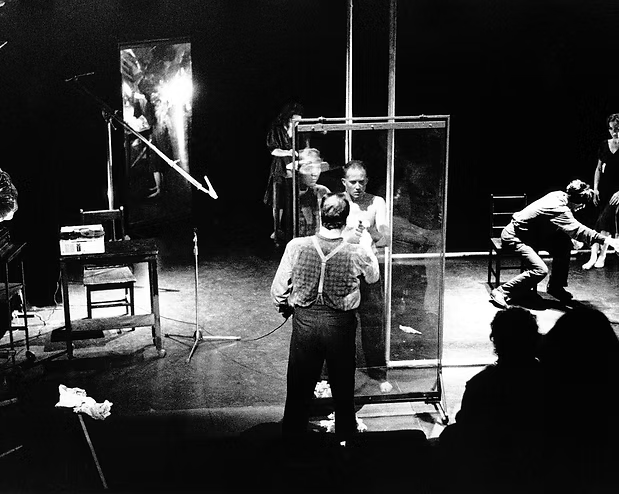
Images held in the Entr’acte Archives
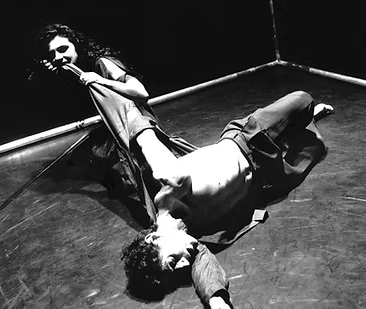
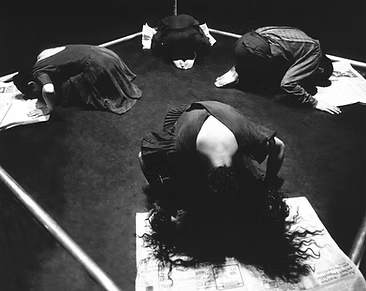
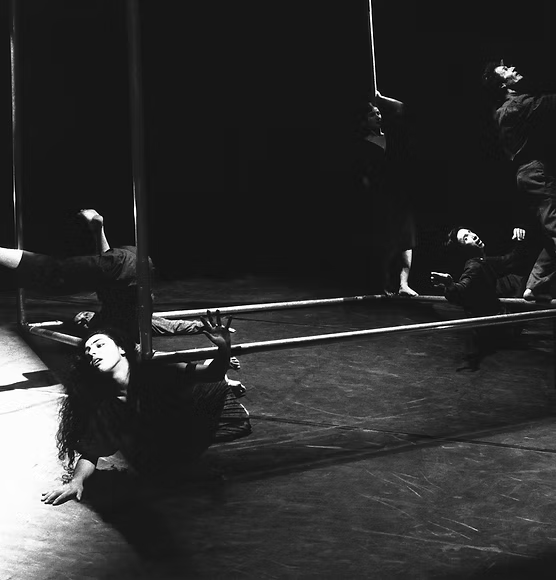
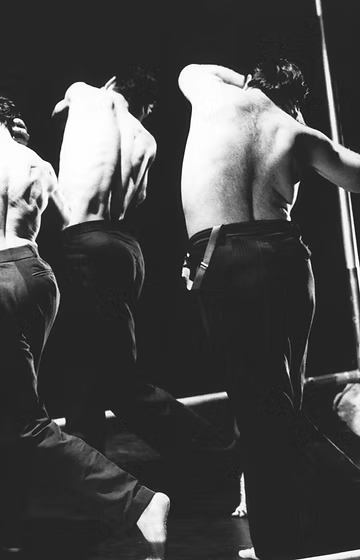
Entr’acte’s corporeal theatre is ….. very aesthetically and intellectually satisfying
Samela Harris, The Advertiser, Adelaide, Mar. 14, 1990
Entr’acte Theatre is celebrating its 10th anniversary with the boldest and most challenging production of its career. The Memory Room is an amalgam of words and movement, with each of these key performing elements delivered in a generously layered style to offer a theatrical experience that is rich and complex.
Jill Sykes, The Sydney Morning Herald, Sat. Sept.16, 1989
Corporeal Theatre
Corporeal Theatre, created by Etienne Decroux (1898-1991), was known in France as le mime corporel. Burke and Thibaudeau replaced ‘mime’ with ‘theatre’, inviting deeper discourses about the role of movement for the actor.
In Australia, it took on an antipodean inflexion. From 1986 onwards, Entr’acte’s signature training practice was complemented by vocal, breath and/or other physical theatre workshops.
Corporeal Theatre companies generally shun a star-based Eisteddfod model of winners and losers: they work as a collective in which each performer emerges with a new ‘best’.
Decroux’s interest in the actor-as-artist began with a desire and conviction that the body could be as articulate as the voice. He observed, reflected, analysed, experimented and discussed his research with colleagues. As a builder and a hospital orderly in his youth, he had witnessed how outstanding artisans and aides brought efficiency, strength, intelligence, love and grace to their tasks – qualities he sought in the actor. He then critically observed the trained body in ballet, boxing and Cambodian dance. This life+art study gave cultural and artistic depth to his newly devised character-types, stylised walks, and abstract movements. For example, the actor’s arm might portray a physical act, such as hammering a nail or, more abstractly, suggest the rhythm of a thought.
“
Donna Sadka, The West Australian,
Apr.5, 1984
It is a cumulative experience, leaving behind a sense of satisfaction in finding a new way of seeing and listening to movement. (Review of Refractions)
“
Jill Sykes, The Sydney Morning Herald,
Sept 13, 1980
Elisabeth Burke and Pierre Thibaudeau have astonishing mastery over their muscles. Their skilful shifts of weight and balance can be caught and held as surely as a film might be halted in mid-action. (Review of duo show The Shape of Time).
Artists in Entr’acte’s major productions
The Shape of Time (1980-1982)
Refractions (1983-1987)
Timescape (1986)
Archeologic (1986): Ostraka (1986-1988) & On Archeology
The Last Circus (1988)
The Memory Room (1989-1992)
Possessed/Dispossessed (1990-1992)
Waterborne (1993)
Eclipse (1995)
On Stage:
Andrea Aloise, Scott Blick, Leslie Buckley, Elisabeth Burke, Bob Burton, Paul Charlier, Rose Clemente, Geoff Cobham, Sarah Dunne, Michelle Fox, Peter Garran, Ben Grieve, Blair Greenberg, Terry Hansen, Rosie Herbert, Greg Hordacre, Sawang Jabo, Michline Jammal, Evdokia Katahanas, Nigel Kellaway, Bruce Keller, Kayoko Kitamichi, Derek Kreckler, Wayne Deborah Leiser, Andrew Lindsay, Christian Mattis, Gisèle Milon, Katia Molino, Collin Offord, Denis Olsen Deborah Pollard, Chris Ryan, Jane Schneider, Leisa Shelton, Janice Slater, Splinters (David Branson, Anne-Marie Sinclair, Simon Terril), Rachael Swain, Todd Swenson, Ta Duy Binh, Ami-Lee Taylor, Pierre Thibaudeau, Christian Tremblay, Nick Tsoutas, Aurel Verne, Fiona Waite, Brian Wilkinson, Indra Utama.
Off Stage: (some performers also held significant off-stage roles) :
Christopher Allen, Richard Allen, Corrie Ancone, John Baylis, Pascal Baxter, Simon Bennets, Big City Productions, David Bishop, Gerard Brophy (with Michael Askill, Richard Millar, Colin Piper), Jean-Louis Buhagiar, Elizabeth Burton, Julieanne Campbell, Bret Cochrane, Melody Cooper, AnneMaree Dalziel, Rick Harrison, Tony Hughes, Catherine De Lorenzo, Sarah De Jong, Brian Findlay, Mary-Ellen Flannery, Keith Gallash, Elio Gatti, Stewart Graham, Rick Harrison, Arif Hidayat, Tony Hughes, Christopher John, Peter Kerin, Regis Lansac, Robert Lloyd, Heidrun Löhr, Anne Lowe, Gary Luke, Derek Nicholson, Trevor O’Connor, Peter Oldham, Janine Peacock, Bob Seary, Mathew Serventy, Mark Shelton, Snuff Puppets, Efterepi Soropos, Paul Spedding, Robyn Stacey, Josef Stejskal, Margaret Tuckson, John Webber, Simon Wise.
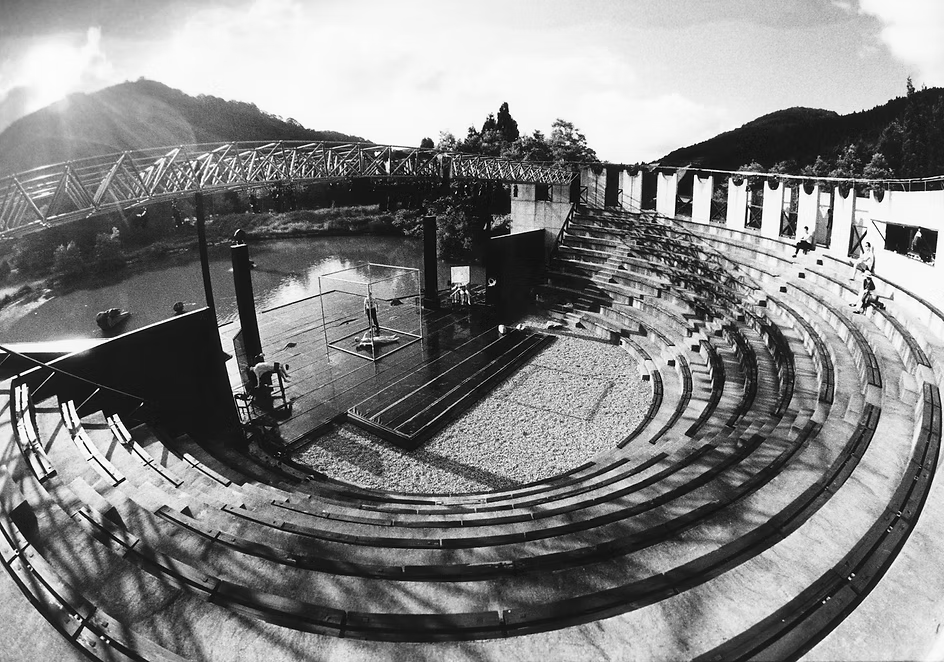
Photographer: Brett Cochrane
Images held in the Entr’acte Archives
Full list of reviews over 20 years is referenced on the AusDance site on Trove.
Note: from 1979 to 1982, Entr’acte Theatre Ltd was known as Sydney Corporeal-Mime Theatre.